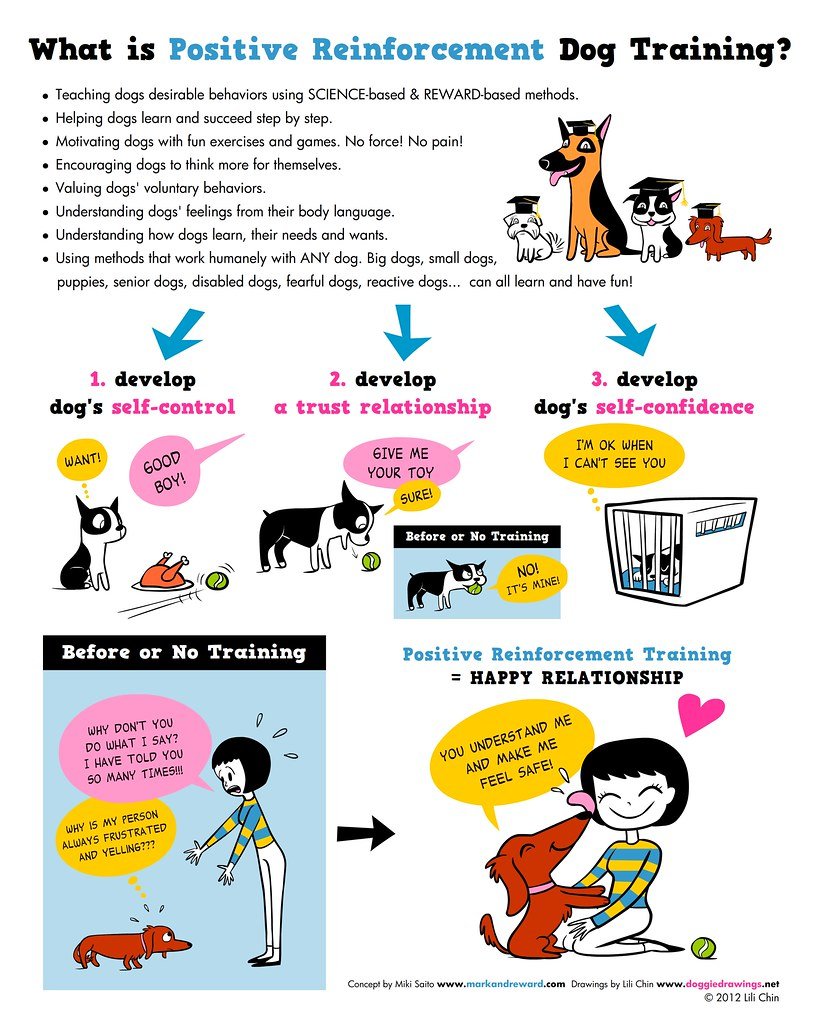Silent as a whisper, still as a stone, a dog’s tranquility is an elusive dream for many pet owners. Whether it’s incessant barking, howling, or even the occasional boisterous yapping, the euphony of silence seems like an unattainable fantasy for those seeking peace in their furry companions. But pause for a moment, for hope might not be entirely lost. Can you train a dog to be quiet? Perhaps, with the right tools, knowledge, and a sprinkle of patience, silencing the symphony that resonates from your canine counterpart might just become a reality. So, let us embark on a journey through the labyrinthine world of canine communication, as we unravel the secrets to training our four-legged friends to find solace in silence.
Table of Contents
- Understanding the Causes of Excessive Barking: Unveiling the Root of the Problem
- Effective Training Techniques: How to Teach Your Dog to Be Quiet
- Implementing Positive Reinforcement: Encouraging Silence and Calm Behavior
- Strategies for Managing Barking: Techniques to Minimize Excessive Noise
- Seeking Professional Help: When and How to Involve a Dog Trainer or Behaviorist
- Q&A
- Future Outlook

Understanding the Causes of Excessive Barking: Unveiling the Root of the Problem
Ever wondered why your furry friend can’t seem to keep quiet? Excessive barking in dogs can be quite a nuisance and often leaves owners scratching their heads in search of a solution. However, before embarking on behavioral training or seeking professional help, it is crucial to understand the underlying causes behind this incessant barking.
In order to decode your dog’s excessive barking, let’s take a closer look at some possible triggers:
- Loneliness and boredom: Just like humans, dogs long for companionship. A lonely or bored dog may resort to excessive barking to seek attention or relief from their monotonous routine.
- Anxiety and fear: Dogs are known to be sensitive beings, and anxiety or fear can trigger their barking mechanism. They may perceive certain situations or objects as threats, resulting in heightened alertness and vocalization.
- Territorial behavior: Dogs have a natural instinct to guard their territory. Excessive barking can occur when they feel the need to protect their home and alert their owners of potential intruders or unfamiliar noises.
These are just a few examples of the root causes that may lead to excessive barking in dogs. By understanding the underlying triggers, it becomes easier to address the problem effectively and provide tailored solutions for our beloved four-legged companions.

Effective Training Techniques: How to Teach Your Dog to Be Quiet
Find the Root Cause of Barking
Before diving into training techniques, it’s vital to understand why your furry friend is barking excessively. Dogs bark for various reasons such as boredom, fear, loneliness, or even excitement. By identifying the underlying cause, you’ll be able to address the issue more effectively. Keep in mind that dogs communicate through barking, so completely eliminating it might not always be the goal. Instead, aim for teaching them situational awareness and appropriate responses.
Teach the “Quiet” Command
Enlisting the power of commands, the “Quiet” command is an invaluable tool to teach your dog. Start by creating a quiet environment where distractions are minimized. With a calm and assertive tone, say “Quiet” clearly and wait for your dog to pause their barking. The moment they stop, reward them with treats and praise. Repeat this process consistently, gradually increasing the timeframe of required silence before rewarding. Soon your dog will associate the “Quiet” command with positive reinforcement, leading them to learn this important skill.
Distraction and Desensitization
Another technique to help your dog become quieter is through distraction and desensitization. Identify triggers that set off their barking and gradually expose them to these stimuli in a controlled manner. For example, if your dog tends to bark at passing cars, start by introducing distant traffic noises and reward them for remaining quiet. Gradually move closer to the road over time, ensuring your dog remains calm throughout the process. This technique helps desensitize your dog to the triggers, teaching them that excessive barking is unnecessary in these situations.

Implementing Positive Reinforcement: Encouraging Silence and Calm Behavior
Creating a harmonious and peaceful atmosphere in any setting requires effective strategies to encourage silence and calm behavior. Implementing positive reinforcement techniques is key to achieving this goal. By acknowledging and rewarding individuals who exhibit quiet and composed behavior, we can cultivate an environment that promotes tranquility and mindfulness.
Here are some practical ways to implement positive reinforcement:
- Recognition: Recognize individuals who consistently demonstrate silence and calm behavior. Encouraging words and affirmations can go a long way in reinforcing their positive actions.
- Rewards: Offer small incentives or rewards as a token of appreciation for those who actively contribute to maintaining a serene atmosphere. This could be in the form of certificates, small gifts, or even extra privileges.
- Modeling: Lead by example by displaying silence and calm behavior yourself. When others see your composure and peacefulness, they are more likely to follow suit.
- Guided Activities: Incorporate guided activities such as meditation, deep breathing exercises, or mindfulness sessions into daily routines. These practices not only promote silence and calmness but also provide individuals with the tools to manage stress and anxiety.
Remember, positive reinforcement is a powerful tool to reinforce desired behaviors. By implementing these strategies, we can create an environment that fosters silence and calm behavior, promoting overall well-being and a peaceful coexistence.

Strategies for Managing Barking: Techniques to Minimize Excessive Noise
Is your furry friend a bit too vocal? Don’t worry, we’ve got you covered with some effective strategies for managing barking and creating a quieter environment for both you and your pet.
1. Identify the Trigger: Understanding why your dog barks excessively is the first step towards managing the behavior. Is it due to boredom, fear, separation anxiety, or a response to certain stimuli? Keep a journal to help you pinpoint the triggers and tailor your approach accordingly.
2. Engage in Mental and Physical Stimulation: A tired pup is a quiet pup! Regular exercise and mental stimulation, such as puzzle toys or obedience training, can alleviate pent-up energy and reduce excessive barking. Channeling their energy into positive activities will keep their minds occupied and content.
3. Counter-Conditioning Techniques: By gradually exposing your furry friend to the triggers that make them bark, you can desensitize them over time. Start with low-level exposure and reward calm behavior. This positive reinforcement will help rewire their responses and teach them alternative ways to cope with stressors.
4. Seek Professional Help: If your efforts aren’t yielding the desired results, don’t hesitate to seek professional advice. A certified dog trainer or animal behaviorist can provide personalized guidance and design a training program that suits your dog’s specific needs. Remember, professional help can make a world of difference!
By utilizing these strategies, you’ll be well on your way to fostering a peaceful and harmonious environment. Keep in mind that consistency and patience are key when managing barking behavior. With love, guidance, and a bit of understanding, you and your four-legged companion can conquer excessive barking together!
Seeking Professional Help: When and How to Involve a Dog Trainer or Behaviorist
Recognizing the Need:
Every dog owner wants their furry friend to be well-behaved and happy. However, sometimes behavioral issues can arise that require professional intervention. Identifying when it’s time to involve a dog trainer or behaviorist is crucial for the well-being of both you and your furry companion.
Common Signs:
- Aggression towards people, other animals, or objects
- Excessive barking, chewing, or digging
- Problems with housebreaking or marking territory
- Fearfulness, anxiety, or separation issues
- Resource guarding or possessiveness
The Benefits of Professional Help:
While some minor behavior issues can be addressed with proper training and socialization, more severe problems often require the expertise of a dog trainer or behaviorist. These professionals have the knowledge and experience to assess your dog’s behavior, identify the underlying causes, and develop a customized plan to address the issues effectively. Additionally, involving a professional can provide you with the guidance and support needed to navigate through the training process.
Remember, seeking professional help for your furry friend is not a sign of failure but rather an investment in their well-being. By recognizing the signs and involving a dog trainer or behaviorist when necessary, you can help your furry friend live a happier and more balanced life.
Q&A
Q: Can you train a dog to be quiet?
A: Yes, with consistent and positive training methods, you can teach your dog to become quieter on command, but it’s important to remember that complete silence may not be realistic or natural for all dogs.
Q: How can I train my dog to be quiet?
A: Start by identifying the triggers that cause excessive barking and address them accordingly. Use positive reinforcement to reward moments of calmness and teach a “quiet” command paired with silence. Consistency and patience are key!
Q: Is it possible to train all dog breeds to be quiet?
A: While it is possible to decrease excessive barking in any dog breed, some breeds, like certain hound or terrier types, are naturally more vocal due to their genetic predisposition. It may require more effort and consistency to manage their barking tendencies.
Q: Can training a dog to be quiet negatively affect their overall behavior?
A: No, when done correctly, training a dog to be quiet using positive reinforcement techniques will only have a positive impact on their overall behavior. It helps establish better communication and builds a stronger bond between you and your furry friend.
Q: Are there any alternatives to training a dog to be quiet?
A: If training alone doesn’t yield desired results, considering professional guidance or seeking help from a certified dog behaviorist is an alternative worth exploring. They can assess the root causes of excessive barking and provide tailored solutions to manage it effectively.
Q: Is it possible to teach an older dog to be quiet?
A: Absolutely! Dogs of all ages can learn new behaviors and commands, including being quieter. However, older dogs might take a bit more time and consistency to change deeply ingrained habits, but with patience and positive reinforcement, it can be achieved.
Q: Can using tools like shock collars or bark collars be helpful in training a dog to be quiet?
A: While some controversial devices like shock or bark collars claim to reduce barking, they often create stress and anxiety in dogs, which can lead to more behavioral issues. It’s always best to opt for positive reinforcement training methods instead.
Q: How long does it typically take to train a dog to be quiet?
A: The duration of training depends on various factors, such as the individual dog, breed, and consistency of the training. Some dogs may show improvement within a few weeks, while others may take a few months to fully grasp the concept of being quiet on command.
Future Outlook
In a world filled with barks, growls, and howls, finding some much-needed peace and quiet can often feel like an impossible dream. But fear not, as we have delved into the mysterious world of canine behavior in search of an answer to the age-old question: Can you train a dog to be quiet? Now, armed with a wealth of knowledge and a newfound understanding, let us reflect on the journey we have taken together.
From the ear-splitting barks that reverberate through the neighborhood to the incessant yapping that tests our sanity, noise pollution caused by our furry companions can strain even the strongest bonds. However, as we just learned, teaching a dog to embrace tranquility is not just a pipe dream, but a feasible and rewarding endeavor.
Throughout this article, we have delved into the depths of canine psychology to uncover the secret to silence. We’ve discovered that barking is a natural form of communication for canines, a language they have perfected over centuries of evolution. However, with the right approach and a touch of patience, we can guide our four-legged friends toward a lifetime of serenity.
Training a dog to be quiet involves a delicate balance between understanding their vocal cues and redirecting their energy into alternative behaviors. By identifying the triggers that set off our furry friends, we can implement positive reinforcement techniques that promote calm and quiet responses. Whether it’s a treat, a gentle touch, or a simple command, the power lies in our hands to shape the behavior of our beloved pets.
Yet, training a dog to be quiet is no effortless feat. It requires dedication, consistency, and unwavering love. There may be days when frustration sets in, and progress feels like a distant memory. But remember, dear reader, that Rome wasn’t built in a day, and neither are well-behaved and tranquil pups. Perseverance in the face of adversity will ultimately lead to a newfound harmony within your household.
So, as we bid farewell to this introspective journey, armed with newfound knowledge and understanding, may you embark upon the quest to silence with conviction and compassion. Remember, dear readers, that training a dog to be quiet is not a matter of suppressing their spirit, but rather a method of fostering a harmonious coexistence between human and canine.
In this world filled with incessant noise, we hold the key to unlocking a symphony of tranquility. Through patience, understanding, and a whole lot of love, we can transform cacophony into a sweet melody of silence. As the curtain falls on this exploration into the realm of canine behavior, may it serve as a reminder that training a dog to be quiet is within our grasp – a beautiful symphony in which both human and canine find solace. And as we venture forth, may we cherish the bond between us and our furry companions, for it is through patience, love, and understanding that true harmony can be achieved.
As an affiliate, my content may feature links to products I personally use and recommend. By taking action, like subscribing or making a purchase, you’ll be supporting my work and fueling my taco cravings at the same time. Win-win, right?
Want to read more? Check out our Affiliate Disclosure page.